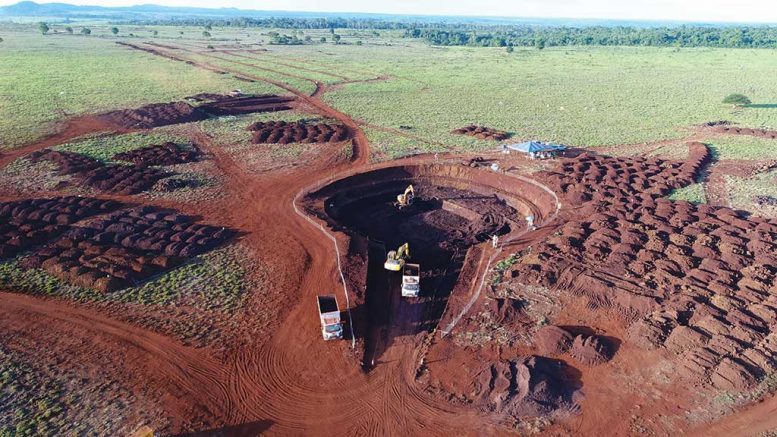Six months ago, Jeremy Martin, founder and CEO of Horizonte Minerals (TSX: HZM; LON: HZM), bought the Vermelho nickel-cobalt project in Brazil from Vale (NYSE: VALE) for US$8 million in cash.
Vale had spent US$200 million drilling it out and delivering a feasibility study showing a production capacity of 46,000 tonnes nickel and 2,500 tonnes cobalt a year over a 40-year commercial life.
Vermelho is one of the largest, highest-grade, undeveloped laterite nickel-cobalt resources globally, and Vale had intended it to become its principal nickel-cobalt operation, Martin says.
In 2005, the Brazilian miner approved a US$1.2-billion investment to build the mine, but the project was put on the back-burner after Vale acquired Inco for $19.4 billion in October 2006.

Jeremy Martin, founder and CEO of Horizonte Minerals.
“We paid US$2 million upfront and the balance is on first production, and everyone goes, ‘What’s wrong with it?’” Martin says. “But the deal was struck at the bottom end of the nickel market — it was only late last year that nickel started to move, and then it moved quite aggressively.”
Nickel prices have increased from US$4 per lb. in January to US$6.99 per lb. at press time — up 75% — and with looming deficits due to a decade of underinvestment in the metal, coupled with growing demand for stainless steel and electric vehicles (EVs), Horizonte finds itself in a sweet spot.
Two-thirds of global nickel production is used to produce stainless steel, and 3% of nickel goes into batteries used in EVs and renewable energy storage. But both end uses could grow quickly in the coming years.
Nickel demand in stainless steel grew 9% last year and more growth is forecast this year and beyond, while EVs could rise from 3 million at press time to more than 320 million by 2040, or 15% out of a total car fleet of 2 billion, according to BP Energy Outlook.
Two of the commonly used lithium-ion battery chemistries contain nickel: nickel cobalt aluminum and nickel manganese cobalt. Estimates from the Nickel Institute suggest that by 2025, 58% of all lithium-ion batteries will contain nickel, which is up from 39%.
“It’s very rare for there not to be an EV nickel-cobalt story in the press every day or every second day. It’s mind-blowing,” Martin says. “We’ve built out Horizonte in a six-year period where nickel has been trading at 15-year lows, and there has been no investment in the sector.”
Horizonte plans to make nickel sulphate directly for Vermelho, rather than produce a mixed hydroxide that would need upgrading by battery manufacturers to generate nickel sulphate — which is Vale’s plan. Horizonte is conducting test work to show it can produce high-grade nickel and cobalt sulphate for the battery market, and the results will feature in a preliminary economic assessment that should be ready before year-end.
In the meantime, the company updated Vermelho’s resource in May to 167.8 million measured and indicated tonnes grading 1.01% nickel and 0.06% cobalt (at a cut-off grade of 0.9% nickel equivalent) for 3,700 million lb. nickel and 207 million lb. cobalt.
But Vermelho isn’t Horizonte’s only nickel project in Brazil’s Carajas mining district, nor is it the company’s flagship asset.

Inside the processing facilities at Horizonte Minerals’ Araguaia project in Brazil. Credit: Horizonte Minerals.
That designation goes to Araguaia — one of the largest, undeveloped saprolite resources globally — which the company hopes will produce a ferronickel product for the stainless steel market by the first quarter of 2021. Ferronickel is preferred by stainless steel mills due to its iron content.
The project has proven and probable reserves of 24.7 million tonnes grading 1.77% nickel for 436,000 tonnes nickel.
The company is 80% through a feasibility study that it says could show an initial 28-year mine life based on average nickel production of 14,500 tonnes per year, for average ferronickel production of 50,000 tonnes a year.
A 2016 prefeasibility study showed more than US$1 billion in free cash flow over the life-of-mine at US$12,000 per tonne nickel.
Araguaia and Vermelho are just 85 km apart in the Carajas mining district, an established mining region with well-developed infrastructure that includes rail, roads and hydroelectric power.
Horizonte is focused on completing its feasibility study on Araguaia before September. It will then move into the project finance stage. Martin says project financing will combine debt, equity and offtake, and that Araguaia is of interest to private equity firms.
“There aren’t that many projects of this quality in the market that are construction ready, and we want to start construction early next year,” Martin says. “There’s also interest in the stainless steel space as well, so it’s a bit of a changing dynamic in the last eight months on the increasing nickel price. They are seeing nickel units substituted into the battery space, and they want to make sure they have access to feed for stainless steel.
“Stainless steel is growing at 5% to 8% a year, and then you’ve got this massive growth in the EV space. So whatever way you look at it, you need a lot of nickel units coming on,” Martin says. “Where are they going to get their nickel from?”
The company has a $100-million market capitalization, and its shares have traded on the TSX between 3.5¢ and 11¢ per share over the last year.
At press time, Horizonte’s shares were changing hands at 7¢ apiece.
Key shareholders as of May 10 include Teck Resources (TSX: TECK.B) at 14.7%; Canaccord Genuity Group (TSX: CF), 10.5%; JP Morgan, 8.2%; City Financial, 7.6%; Lombard Odier, 6.9%; Richard Griffiths, 6.7%; Hargreaves Lansdown, 5.4%; and Glencore, 5.2%.


Be the first to comment on "Horizonte Minerals advances two assets in Brazil"